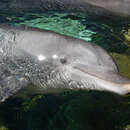Diagnostic Description
provided by FAO species catalogs
The bottlenose dolphin is probably the most familiar of the small cetaceans because of its coastal habits, prevalence in captivity worldwide, and frequent appearance on television and in advertising. It is a large, relatively robust dolphin, with a short to moderate length stocky snout that is distinctly set off from the melon by a crease. The dorsal fin is tall and falcate, and set near the middle of the back. Colour varies from light grey to nearly black on the back and sides, fading to white (sometimes with a pinkish hue) on the belly. The belly and lower sides are sometimes spotted. There is a dark stripe from eye to flipper, and a faint dorsal cape on the back (and sometimes an indistinct spinal blaze), generally only visible at close range. Often, there are brushings of grey on the body, especially on the face, and from the apex of the melon to the blowhole. Bottlenose dolphins have 18 to 26 pairs of robust teeth in each jaw. In older animals, many of these may be worn down or missing. In many areas of the world, such as South Africa, the Northwest Atlantic, Peru, and the eastern North Pacific, there appear to be 2 forms, a coastal type and an offshore type; however, the taxonomy of bottlenose dolphins is still somewhat confused, due to the great extent of geographical variation.Can be confused with: Bottlenose dolphins can be mistaken for several other species of dolphins, depending on the area. There can be confusion in the tropical Atlantic with Atlantic spotted dolphins, along the east coast of South America with dolphins of the genus Sotalia, and in the Indo-Pacific and off West Africa with hump-backed dolphins. When seen from a distance, they could also be confused with Risso's dolphin or rough-toothed dolphin. Such confusion will generally only occur when the animals are not seen well; in most situations, bottlenose dolphins are distinctive.
- bibliographic citation
- Marine mammals of the world. Jefferson, T.A., S. Leatherwood & M.A. Webber - 1993. FAO species identification guide. Rome, FAO. 320 p. 587 figs. .
- author
- Food and Agriculture Organization of the UN
Size
provided by FAO species catalogs
Adults range from 1.9 to 3.8 m, with males somewhat larger than females. There is incredible variation between different populations. Maximum weight is at least 650 kg, although most animals are much smaller. Length at birth is about 1 to 1.3 m.
- bibliographic citation
- Marine mammals of the world. Jefferson, T.A., S. Leatherwood & M.A. Webber - 1993. FAO species identification guide. Rome, FAO. 320 p. 587 figs. .
- author
- Food and Agriculture Organization of the UN
Brief Summary
provided by FAO species catalogs
More is known of the biology of this species than of any other dolphin. Group size is commonly less than 20, but large herds of several hundred are often seen offshore. Bottlenose dolphins are commonly associated with other cetaceans, and hybrids with other species are known from both captivity and in the wild. Based on a number of studies of nearshore populations, bottlenose dolphins seem to live in relatively open societies. In some areas, dolphins have limited home ranges; in others, they are migratory, generally ranging further. Mother and calf bonds and some other associations may be strong, but individuals may be seen from day-to-day with a variety of different associates. The bottlenose dolphin is the most common species of dolphin held in captivity. It has proven highly adaptable and is easily trained. Much of what we know of the general biology of dolphins comes from studies of bottlenose dolphins, both in captivity and in the wild. Bottlenose dolphins are sometimes active (especially when feeding or socializing), often slapping the water with their flukes, leaping, and performing other aerial behaviours. Spring and summer or spring and autumn calving peaks are known for most populations. They are opportunistic feeders, apparently taking whatever suitable prey is most abundant at the time. Feeding behaviour is varied, ranging from cooperative foraging on schooling fish, to individually chasing fish onto mudbanks, to feeding behind shrimp trawlers and other fishing operations.
- bibliographic citation
- Marine mammals of the world. Jefferson, T.A., S. Leatherwood & M.A. Webber - 1993. FAO species identification guide. Rome, FAO. 320 p. 587 figs. .
- author
- Food and Agriculture Organization of the UN
Benefits
provided by FAO species catalogs
Both incidental and direct exploitation of bottlenose dolphins are known to occur, generally at low to moderate levels. The largest direct kills have traditionally been in the Black Sea, where Russian and Turkish hunters apparently have reduced local populations. Bottlenose dolphins also are taken elsewhere in gillnets, shark nets, shrimp trawls, and purse seines (the latter in the multi-national tuna purse seine fishery of the eastern tropical Pacific). They also are occasional victims of harpoon and drive fisheries. Live capture removals have had considerable effects on some populations, such as those in the Gulf of Mexico and U.S. southeast coast. IUCN: Insufficiently known.
- bibliographic citation
- Marine mammals of the world. Jefferson, T.A., S. Leatherwood & M.A. Webber - 1993. FAO species identification guide. Rome, FAO. 320 p. 587 figs. .
- author
- Food and Agriculture Organization of the UN

